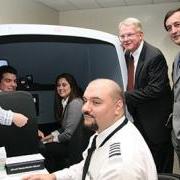|
Farmingdale Chapter President Yolanda Pauze was a study in concentration as she sat in the cockpit of the new flight simulator, her eyes fixed on the computer screen straight ahead. “Wow, this is amazing,” Pauze said. “It’s like being in an actual airplane.” That’s why students and instructors at Farmingdale’s aviation program are so excited about the acquisition of the $90,000 simulator—a device the college wouldn’t have without the initiative and persistence of Farmingdale UUPer Barbara Maertz. Maertz was instrumental in helping the college secure a state grant that paid for the training device. From its controls to its instruments and Global Positioning System (GPS), the Frasca flight training device is a replica of cockpits found in single- and double-engine aircraft. Students can practice taxiing up the runway, taking off, cruising, descending and landing, while their instructor—sitting at a computer just to the side of the simulator—feeds in real-time scenarios and weather hurdles, such as snow, clouds and rain. The simulator was unveiled during a Dec. 10 press conference at Farmingdale’s Aviation Center at Republic Airport. “It’s a true representation of what can happen in the air,” said Mike Hughes, a UUPer and the aviation program’s director of operations. “It’s the best possible way to teach and save dollars.” “Students can practice emergency situations, like fire, smoke in the cockpit, engine-out procedures and navigation problems, that are too dangerous to do in the air,” said Farmingdale UUPer Steve Campbell, the aviation program’s chief pilot. “No one will ever crash and burn using a simulator.” The quest for a new simulator began seven years ago, when Campbell met with Maertz and asked if there was anything UUP could do to help secure funding for a new flight simulator. The aviation program, one of the oldest in the country, has been using older flight training devices that are still in use but are not compatible with GPS systems. Maertz took the request to Assemblyman Robert Sweeney (D-Lindenhurst), who eventually secured a grant through the Dormitory Authority of the State of New York. Sen. Charles Fuschillo Jr. (R-Merrick) also aided in delivering the dollars. But bureaucratic red tape from the state, tie-ups due to the grant being linked to another Farmingdale project that never took off, and delays by the school’s administration to place an order for the simulator kept the apparatus out of reach for a long time, she said. “It took a while, but we were finally able to make this project a reality and the union membership is thrilled,” said Maertz. “I am very proud to have had a part in this.” During the press conference, Sweeney acknowledged Maertz’s efforts, saying that she “doggedly persisted” until the grant was awarded. “I have to say that this wouldn’t have happened without the union,” Campbell said. “Barbara had the contacts, she set up the appointments. It was the union that kept asking administrators where things were, that kept following up.” The state-of-the-art device is approved for use by the Federal Aviation Administration (FAA). It will allow students to gain crucial flight experience time without stepping in a plane—and with less stress on their wallets. Students, who pay as much as $200 per hour to fly with an instructor (students usually fly two-hour sessions), will pay between $40 and $45 an hour to use the flight training device, said Sarah Kilkenny, an aviation program senior. “The feel of the flight simulator is so realistic,” said Kilkenny, who has more than 400 hours of FAA-certified flight time. “All the controls and instruments are the same. And the best thing is you can freeze the (simulator), turn around and ask your instructor what you did wrong.” To earn a four-year bachelor of science degree and become an entry-level pilot, students must complete 64 credits of liberal arts and science courses and 65 credits of aviation and flight courses. Students can also earn a number of pilot certificates, including certified flight Instructor (CFI), CFI multiengine instructor, and private pilot certificate. Kilkenny and Farmingdale senior aviation student Ray Castaldini said they plan to make good use of the simulator, as will the rest of the 60-plus aviation students, Hughes said. “It will certainly help us attract students when they see it at our open houses,” Campbell said. “They get excited when they see things like this.” — Michael Lisi |
Warning: count(): Parameter must be an array or an object that implements Countable in /home/uuphos5/public_html/voicearchive/wp-includes/class-wp-comment-query.php on line 405


